Abstract
With the advancement of the Internet of Things, the LoRa Alliance produced the Long-Range Wide-Area Network (LoRaWAN) Specification, allowing end-devices to transit through a gateway and join the LoRa network after completing a join procedure. When an end-device joins the LoRaWAN network, it must send a join request message to the network server and wait for the network server to verify such request under the current LoRaWAN join protocol. However, as the number of end-devices grows exponentially, network server verification messages will grow linearly with the number of end-devices. This paper proposes an authentication system for multiple end-devices that complies with the LoRa Alliance’s specifications and decreases the joining latency imposed by the network server verifying messages. The proposed authentication system is formally secure against the server and end-device impersonation. In addition, we assess the authentication overhead and compare it to the standard approach.
1. Introduction
The IoT has enabled various applications in the past few years, including smart homes, smart cities, industrial automation, and smart healthcare [1,2]. According to Ericsson’s mobility report [3], the number of IoT devices exceeded the number of mobile devices in 2018. Furthermore, as illustrated in Figure 1, according to a Statistica report in 2018 [4], IoT devices will have over 75 billion connections by 2025. Furthermore, since technology advances and times change swiftly, consumers have exhibited a greater demand for automated IoT devices and consume less power. This means that previous wireless communication technologies such as Bluetooth Low Energy (BLE), Zigbee, and Wi-Fi are no longer capable of meeting the needs of IoT devices for long distances, low energy consumption, and a high density of nodes. Furthermore, according to the LoRa Alliance [5] and Sinha et al. [6], the Low-Power Wide-Area Network (LPWAN) industry is on the rise in the IoT market. In this scenario, low-power wide-area network (LPWAN) communication technology has recently become a prominent wireless communication technology [7,8].

Figure 1.
Connected IoT devices (in billions) from 2015 to 2025.
LoRa [9] is a well-developed technology among these LPWAN technologies. The LoRa technology was developed by the French company Cycleo and bought by Semtech in 2012. Following the acquisition, Semtech commenced an aggressive increase in the use of the technology, including forming the LoRa Alliance to make it easier for other firms to join the LoRa ecosystem. LoRa technology [10] bridges the technical gap between Wi-Fi/BLE and cellular-based networks, such as the 5G network [11], and can provide long-distance data connections with minimal power consumption, as shown in Figure 2. Cisco, one of the LoRa Alliance’s pioneers, presented the following three LoRa application use cases [12]:
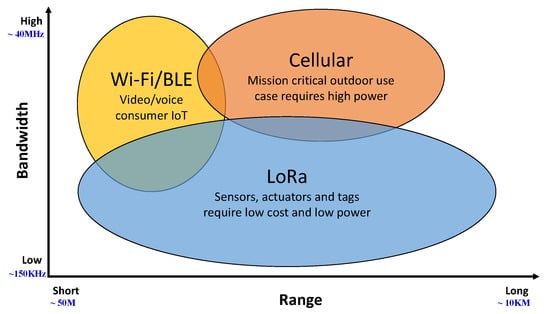
Figure 2.
LoRa filling the technology gap.
- Smart city management: Connecting all the assets of the city and providing better services by collecting data and analyzing data, including waste management, parking, street lighting, and public safety data.
- Asset tracking: Obtaining location information for people and private assets, including equipment, vehicles, pets, and cattle.
- Gas and water metering: Enabling utility customers to remotely read and control gas and water meters to reduce technical costs.
The LoRa Alliance released the first version of the LoRa communication standard specifications in 2015, designating the Long Range Wide-Area Network (LoRaWAN) to enable LoRa to be applied to the abovementioned areas. According to the LoRa Alliance’s introduction overview document issued in 2015 [13], LoRaWAN has the following benefits:
- Long range: Not only can LoRaWAN serve indoor applications in unlicensed bands such as Wi-Fi, but it can also support outdoor applications with the same security as a cellular network [14]. As a result, it can connect to a broader range of networks than Wi-Fi and cellular networks.
- Max lifetime: Asynchronous communication is the most extensively utilized mode for end-devices in the LoRaWAN network. End-devices only communicate over the network when sending event-driven or planned data. As a result, they can conserve the wake-up monitoring power. End-devices in other synchronous networks must wake up frequently in order to synchronize with the network and verify messages, which consumes more power.
- Multi-usage: Depending on the environment, the LoRaWAN network may handle public networks with a significant capacity of hundreds or even tens of thousands of nodes. As a result, it can meet the needs of large online communities or markets [15].
- Low cost: Low power consumption in LoRa end devices enhances battery life and lowers battery replacement expenses. Semtech has also made the hardware and software designs for the gateway and end-devices public. This can help to save money on infrastructure and terminal device development.
- Device classes: End-devices are used for a variety of purposes and have varying needs. LoRaWAN has created three end-device categories, dubbed class A, B, and C, to optimize diverse end-application profiles to balance network downlink communication delays and battery life.
- Security: To ensure end-to-end security, LoRaWAN employs Advanced Encryption Standards (AES) [13]. Mutual authentication and integrity protection also ensure the integrity of LoRa networks, devices, and data [14].
Chen et al. [16] developed a key generation strategy for LoRaWAN that meets the security key randomization criterion. Danish et al. [17] developed a lightweight two-factor authentication system for the LoRaWAN join procedure based on blockchain technology, ensuring confidence between network servers. Later, Tsai et al. [18] established a session key generation mechanism that allows two servers to interact with each other, considerably improving the LoRaWAN Specification’s undefined application-layer communication security securely. For LoRaWAN networks, Jabbari and Mohasefi [19] created a novel secure user-authenticated key establishment mechanism. It allows participants to verify each other’s identities. Furthermore, it enables users and end-devices to establish a secure session key between themselves without trusting the network server unconditionally. Further, Kaven et al. [20] proposed a scheme to combat additional Sybil and man-in-the-middle threats. However, most of the methods do not consider the authentication of multiple end-devices and thus suffer from high latency during real-life deployment.
1.1. Contributions
When an end-device wants to join a network, it must send a join request to the network server, which will execute the join verification process [21]. With the growing number of end-devices, the number of join verification tasks will rise linearly [13]. As a result, if many end-devices want to join the network, the network server will experience a delay when processing such large requests. We propose a multi-device authentication technique based on the LoRaWAN join mechanism to solve this challenge. Within the LoRaWAN framework, we make the following contributions:
- We offer a comprehensive authentication strategy based on the linked end-device(s) features that use exclusive-OR operations to achieve batch authentication.
- The suggested technique allows several end-devices of the same gateway to generate group keys. Supporting group key creation may be helpful for future applications because end-devices from the same gateway may have specific correlations. Furthermore, each end-device requires one additional hash operation.
- Under the formal model, the new technique is protected against major threats such as phoney end-devices, network servers, and the leakage of session keys.
- Considering multi-end-device authentication, the suggested technique saves overall execution time by around 33% compared to the LoRA Specification.
It may be noted that the security evaluation of the proposed scheme is based on the conventional IND-CCA symmetric encryption assumptions and pseudorandom permutation indistinguishability (PRP).
1.2. Organization
The rest of this manuscript is organized as follows: Section 2 mentions some background knowledge relevant to the proposed scheme, including the LoRaWAN standard. The proposed authentication scheme based on the LoRaWAN standard is described in Section 3. The security models and proofs of the proposed scheme are provided in Section 4. Comparisons and concluding remarks are presented in Section 5 and Section 6, respectively.
2. Preliminaries
This section provides background information for the proposed work, including the LoRaWAN architecture with its specifications, and the underlying security games.
2.1. The LoRaWAN Architecture
LoRaWAN is a wide-area network that offers a bi-directional communication protocol for end-devices with long-range, low-power, and low-cost requirements [22]. Figure 3 depicts an overview of the LoRaWAN architecture. The entities defined in the LoRaWAN architecture are described below [13]:

Figure 3.
The LoRaWAN architecture.
- End-Devices: These could be anything from water meters to smoke alarms to trash cans and pet trackers. LoRaWAN divides end-devices into classes A, B, and C. Each type of device fulfills various long-distance communication requirements.
- -
- Class A: This is the most basic communication mode, with minor power consumption. It transmits data in bursts. As a result, network servers and applications cannot predict the communication time. Class A refers to end-devices that only require upload link communications.
- -
- Class B: Class B end-devices will open additional receive windows at predetermined times in addition to the random receive windows of class A devices. The gateway will send a time synchronization signal to the end-devices in order for them to open the receive windows on a predetermined schedule. As a result, the network server knows when the end-devices are listening.
- -
- Class C: The receive windows on class C end-devices are almost always open and only close when transmitting. This end-device consumes the most power, while having the shortest delay because these receive windows remain open.
- Gateways: A device in the LoRaWAN network is not assigned to a specific gateway. Instead, data sent by a node are typically received by multiple gateways. Each gateway will route data packets from the end node to the cloud-based network server via backhaul cellular or Ethernet networks.
- Network Server: This is in charge of managing the entire network through specific functions. It deletes redundant packets and runs security checks when it receives them from gateways. Finally, it sends back an accept message via the best gateway.
- Application Servers: This is in charge of interpreting data from end-devices and solving problems with advanced technologies such as deep learning or artificial intelligence.
2.2. The LoRaWAN Specifications
When the end-device connects to the LoRaWAN network, the following data are stored in the end-device [23]:
- Device EUI (DevEUI): The DevEUI is a global unique end-device identification number that is assigned by the device manufacturer.
- Application EUI (AppEUI): The AppEUI is a global unique application identification number, which is stored in the device in advance by the device manufacturer.
- Application key (AppKey): The AppKey is an AES-128 secret key stored in the end-device and used to derive two keys, NwkSKey and AppSKey.
- Device address (DevAddr): The DevAddr is a 32-bit hexadecimal number, which can be divided into two parts: the network identifier and network address.
- -
- Network identifier (NwkID): The NwkID is a 7-bit network identifier used to distinguish between the addresses of overlapping networks operated by different network operators.
- -
- Network address (NwkAddr): The NwkAddr is a 25-bit network address assigned by the network manager.
- Network session key (NwkSKey): The NwkSKey is a network session key which is used for MAC layer message encryption and authentication.
- Application session key (AppSKey) The AppSKey is an application session key which is used for application-layer message encryption and authentication.
There are two ways for end-devices to join LoRaWAN, according to current LoRaWAN standards. The first is known as over-the-air activation (OTAA), and the second is known as activation by personalization (ABP). We will introduce them briefly.
2.2.1. End-Device Activation
When using OTAA, the end-device must complete the join procedure to connect to the LoRaWAN network. DevAddr, NwkSKey, and AppSKey, on the other hand, are stored directly in the end-device when using ABP to join LoRaWAN. Because the end-device stores the information required for activation, it can join a specific LoRa network when it boots up. The proposed scheme focuses on the join procedure in OTAA mode.
2.2.2. Join Procedure
The join procedure according to LoRaWAN Specification 1.0.3 is depicted in Figure 4. A join-request message and a join-accept message are sent during the join procedure. Before the end-device begins the join procedure, it must be personalized with the following data: DevEUI, AppEUI, and AppKey. The following is a description of the join procedure. First, the end-device sends a join-request message to the network server, including the DevEUI, AppEUI, device nonce (DevNonce), and message integrity code (MIC), which is computed using the AppKey. After verifying the join-request message, the network server derives the NwkSKey and AppSKey as follows:
where and are the port fields for specific applications, AppNonce is an application nonce, NetID is a network identifier, and is a function adding zero octets to make the length of the data a multiple of sixteen. The network server then sends AppSKey to the application server over a secure channel and a join-accept message to the end-device. The join-accept message contains AppNonce, NetID, DevAddr, a delay (RxDelay) between TX and RX, a reserved-for-future-usage field (RFU), and an optional list of channel frequencies for the network (CFList). AppKey encrypts the join-accept message as follows:
where MIC is computed using AppKey. On receiving the join-accept message, the end-device computes NwkSKey and AppSKey as follows:
where AppNonce is an application nonce and NetID is a network identifier.
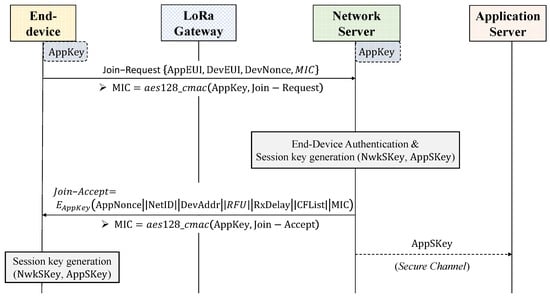
Figure 4.
Join procedure in the LoRaWAN specification.
3. The Proposed Scheme
Table 1 displays the useful notations. This section describes an efficient authentication scheme for massive end-devices in the LoRaWAN join procedure. It is divided into three stages: setup, personalization, and authentication, as shown in Figure 5.

Table 1.
A list of notations.

Figure 5.
Communication between various entities in the proposed scheme.
3.1. Setup
The network server sends an authentication slot to the gateway. Then, the manufacturer chooses a one-way hash function and embeds it to end-devices. For each end-device , it shares with each network server the identity of the end-device and a secret key shared with the end-device . It then publishes the details of symmetric encryption and decryption, and one-way hash functions. Moreover, the device manufacturer sets the parameters according to the LoRaWAN Specifications of the LoRa Alliance.
3.2. Personalization
The device manufacturer must personalize an end-device with:
- : an application global unique identifier
- : a global unique identifier of the end-device
- : a secret key shared between the end-device and the network server
3.3. Authentication
When this phase is completed successfully, end-devices connected to the same gateway share a group session key . The authentication phase consists of the following:
- Step 1: An end-device sends a join-request message to the network server to join the LoRaWAN network. The end-device
- -
- chooses at random and computes a message integrity code
- -
- sends Join-Request, which contains , and , to the network server.
- Step 2: To confirm the join-request, the network server sends a join-confirm message to the end-device. The network server waits until the authentication slot expires. It
- -
- checks the correctness of for each join-request received during the slot.
- If is invalid, then it aborts.
- Otherwise, it selects a random and a common random c.
- -
- It computes and sends it to end-device.
- Step 3: The end-device decrypts the join-confirm message and sends a response message to the gateway. The end-device
- -
- uses to get , and c by decrypting and
- -
- verifies whether is correct.If is incorrect, it aborts; otherwise, it stores c and sends to the gateway.
- Step 4: The gateway collects all the response messages at the time slot and sends a group-response message to the network server for the verification.
- -
- The gateway, on receiving from end-devices at the time slot, sends the group-response message to the network server.
- -
- The network server computes and verifies whether . If it does not hold, the gateway will send to the network server and the network server will verify of each end-device.
- Step 5: The network server sends a join-accept message to the end-devices and sends the session keys to the application server
- -
- The network server computesandand sends - to the end-device.
- -
- The end-device decrypts - with the corresponding . Then, the end-device verifies whether is valid. After that, both the network server and end-device compute a shared session key as
- -
- Finally, the network server sends the corresponding and to the application server for each end-device.
Although we use AES-128, one may use AES-256 to provide higher security. The authentication process is further discussed in Figure 6 in detail.
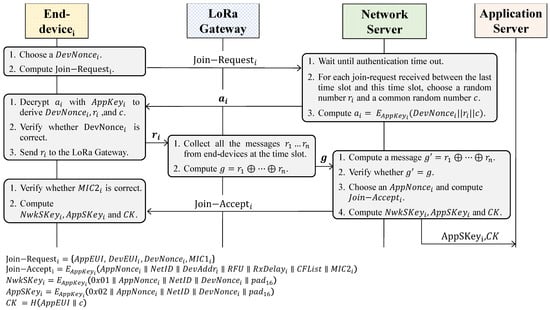
Figure 6.
Authentication process.
4. Security Assurance
The proposed scheme achieves certain security features, such as multi-device authentication, resistance against session key disclosure, and strong protection against fake end-devices and fraudulent servers. Before getting into security proofs, we provide formal security models.
4.1. Security Model
We provide security models for the authentication and session key agreement process. The model is a game [24] between a simulator and a polynomial-time adversary .
- 1.
- Secure Authentication: outputs a target before the game starts.
- Setup: sends system public parameters and the symmetric functions , and sets the key and other public parameters as in the original scheme.
- Training: queries the two oracles as follows:
- -
- Personalization: inputs . If , then sends data transmitted in the personalization phase to . Otherwise, aborts.
- -
- Authentication: inputs and . sends the packages transmitted in the authentication phase to .
- Challenge: picks one of the following two cases and sends to .
- impersonates a network server in the authentication phase to pass the verification. The advantage of winning the game for is .
- impersonates an end-device in the authentication phase to pass the verification. The advantage of winning the game for is .
- 2.
- Secure session key exchange: As like earlier, first outputs a target .
- Setup: sends system public parameters and the symmetric functions , and sets the key and other public parameters as in the original scheme.
- Training 1: queries the two oracles as follows.
- -
- Personalization: inputs . If , then sends data transmitted in the personalization phase to . Otherwise, aborts.
- -
- Authentication: inputs and and sends packages transmitted in the authentication phase to .
- Challenge: sends and two random numbers and . Then, randomly chooses . sends to , where c is a random number chosen by .
- Training 2: queries the same queries in Training 1.
- Guess: guesses whether or 1. The advantage of winning the game for is defined as .
4.2. Security Proof
Theorem 1.
The proposed technique ensures safe mutual authentication and key exchanges between an end-device and the network server.
Proof.
Theorem 1 is established when Lemmas 1, 2, and 3 hold. □
Lemma 1.
The suggested approach is secure against an adversary impersonating the network server based on the indistinguishability of pseudorandom permutation (PRP).
Proof.
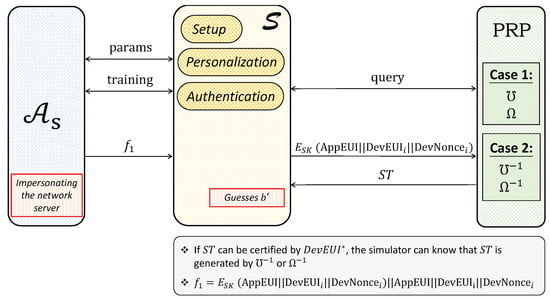
Assume that a polynomial-time adversary impersonates the network server with a non-negligible advantage . Then, we can build a probabilistic polynomial-time simulator with a non-negligible advantage to breach the indistinguishability between a random permutation and a pseudorandom permutation. Before the setup step, generates a target identity . Let stand for the PRP game’s secret key.
- Setup: sets the public parameters and the symmetric functions according to the pseudorandom permutation. After that, it sends the public parameters and the symmetric functions to .
- Training: simulates the following oracles for
- -
- Personalization: sends an end-device identity . If , then returns as in the actual scheme. Otherwise, aborts.
- -
- Authentication: sends and . If , executes the authentication phase of the proposed scheme. Otherwise, selects , c, and , and then queries the encryption oracle of PRP to receive ciphertext and asThen, selects and queries the encryption oracle of PRP to encrypt , , , , and as ciphertext and , whereFinally, receives , , , and from the the simulator .
- Challenge: For , sends to , whereThen, sends to the PRP and chooses case 2 for the challenge. After that, the PRP randomly chooses . If , is a random string acquired by performing the function. If , is a pseudorandom string acquired by performing the decryption function on . As a result, the PRP game returns to .
- Guess: On receiving , checks if is equal to . If the condition is true, knows that is calculated by the decryption function , and thus sets ; otherwise, sets . Finally, sends guess to the PRP.
Therefore, we have , where denotes the advantage of to break the indistinguishability between a random permutation and a pseudorandom permutation. A security proof sketch is further mentioned in Figure 7. □

Figure 7.
The game among , who impersonates the network server; ; and PRP oracles.
Lemma 2.
The suggested technique is secure against an attacker impersonating a legitimate end-device based on the IND-CCA security of the symmetric encryption.
Proof.
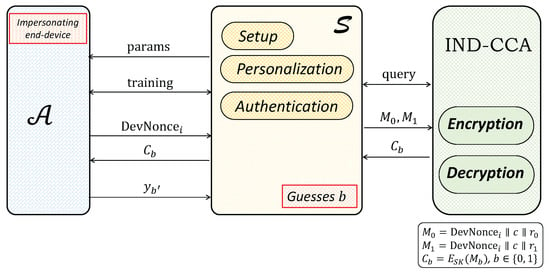
Assume that there exists a polynomial-time adversary who has the non-negligible advantage to impersonate a legal end-device of the proposed scheme. Then, we can construct a probabilistic polynomial time simulator that has the non-negligible advantage to break an IND-CCA symmetric encryption. The adversary outputs a target identity before the setup phase. Let denote the secret key of the underlying IND-CCA symmetric encryption.
- Setup: sets the the public parameters and the symmetric functions according to the IND-CCA symmetric encryption process. Then, sends the public parameters and the symmetric functions to .
- Training: simulates the following oracles for as follows.
- -
- Personalization: inputs an end-device identity to . If , then returns and according to the proposed scheme. Otherwise, aborts.
- -
- Authentication: sends an end-device’s identity and . If , executes the authentication phase of the proposed scheme. Otherwise, selects , c, and , and then queries the encryption oracle of the IND-CCA symmetric encryption to encrypt , , , c and into ciphertext and asThen, selects and queries the encryption oracle of the IND-CCA symmetric encryption to encrypt system parameters: , , , , and to ciphertext and asFinally, receives , , , and from .
- Challenge: sends identity to , where . Then, chooses and to compute and . After that, sends to the IND-CCA oracles to start the challenge phase of the IND-CCA game. Finally, receives given from the encryption oracle and sends it to , where b, chosen by the encryption oracle, is unknown to .
- Guess: outputs a bit to . If , sets ; otherwise, sets . Finally, sends the guess to the IND-CCA game.
Therefore, we have , where denotes the advantage of the simulator to break the IND-CCA symmetric encryption. A security proof sketch is further mentioned in Figure 8. □

Figure 8.
The game among , impersonating the network server; ; and IND-CCA oracles.
Lemma 3.
The proposed method is resistant to an adversary who recovers the session key.
Proof.
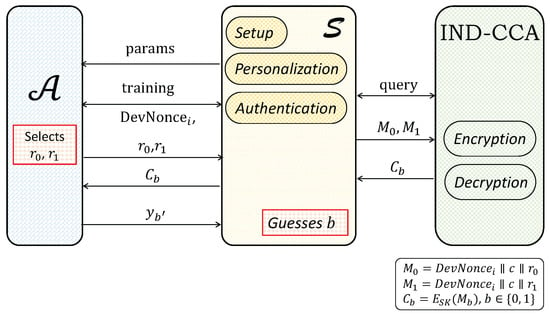
Assume that a polynomial-time external adversary has a non-negligible advantage to reveal the session key. Then, we can construct a probabilistic polynomial time simulator that has the non-negligible advantage to break a known symmetric encryption with IND-CCA security.
- Setup: sets the the public parameters and the symmetric functions according to the IND-CCA symmetric encryption. Then, sends the public parameters and the symmetric functions to .
- Training 1: simulates the following oracles for as follows.
- -
- Personalization: sends an end-device identity . If , then returns and , according to the proposed scheme. Otherwise, aborts.
- -
- Authentication: sends identity and to S. If , executes the authentication phase of the proposed scheme. Otherwise, selects , c and and then queries the encryption oracle of the IND-CCA symmetric encryption to encrypt , and to ciphertext and encrypts c and to ciphertext . Once, receives , it selects and queries encryption oracle of the IND-CCA symmetric encryption for , and gets ciphertext asFinally, receives , , , and from .
- Challenge: sends and of equal-length and , where . Then, computes and and sends to the IND-CCA oracles to start the challenge phase of the underlying IND-CCA game. After that, receives given from the encryption oracle and sends it to , where is unknown to .
- Training 2: can query the same queries as those in Training 1.
- Guess: The adversary outputs a bit to . If , sets ; otherwise, sets . Finally, sends the guess to the IND-CCA game.
Therefore, we have , where denotes the advantage of the simulator to break the IND-CCA symmetric encryption. A security proof sketch is further mentioned in Figure 9. □

Figure 9.
The security game among , who can obtain the session key; ; and IND-CCA oracles.
5. Comparison
This section demonstrates the proposed scheme’s characteristics, computation cost, and performance.
5.1. Security Properties
The proposed scheme’s characteristics are compared to the LoRaWAN specifications in Table 2. The suggested scheme and the LoRaWAN specifications ensure mutual authentication and data integrity. LoRaWAN only checks one end-device per time slot, whereas the suggested scheme certifies several end-devices at the same time.

Table 2.
Functionality comparison.
5.2. Computation Cost
The computation overhead considers the additional cost incurred due to rapid authentication for multiple end-devices in LoRaWAN. We list the hardware information and the computation cost of each operation in Table 3.

Table 3.
Device specification and operation overhead.
In Table 4, the computation cost of the LoRaWAN specifications is compared to the overhead of the proposed method. Although the suggested system involves more computations in the gateway and network server than the LoRaWAN specifications, it has the batch authentication property that the LoRaWAN specifications do not have.

Table 4.
Computation cost.
It is worth noting that the authentication computation cost does not include the cost of computing the shared session key.
5.3. Performance
Based on the work of Lavric and Popa [26] consideration, we set the maximum number of end-devices in the LoRaWAN network to be 1000. Furthermore, we chose these scenarios for comparison since 50 or 100 end-devices are commonly utilized in real-life. Table 5 shows the overall execution time of the proposed scheme and of the LoRaWAN specifications for validating 50, 100, and 1000 end-devices, respectively.

Table 5.
Performance comparison.
Because the LoRaWAN specifications check one device attempting to join the network at a time, the joining method must be repeated 50, 100, or 1000 times in order to verify all end-devices, correspondingly, as shown in Table 5. On the other hand, since the suggested scheme provides batch verification for multiple devices, it only has to be run once in each case to verify all end-devices.
6. Conclusions
Based on the LoRaWAN join procedure, we have presented a secure multi-device authentication scheme. The suggested system can fit the features of natural LoRaWAN environments to reduce join latency. Furthermore, the suggested technique employs the challenge-response and exclusive-OR operations in tandem to obtain batch authentication benefits. As a result, the suggested scheme may be readily integrated into the existing LoRaWAN join mechanism. Furthermore, we anticipate that the suggested approach can be utilized to create a secure and rapid LoRaWAN authentication system that meets the LoRa Alliance’s specifications. In the future, we will consider various real-world scenarios and design effective key management and device revocation processes in multi-device authentication settings.
Author Contributions
Conceptualization, C.-I.F. and C.-H.S.; methodology, C.-I.F., E.-S.Z., A.K., C.-H.S.; software, C.-H.S.; validation, C.-I.F., E.-S.Z. and A.K.; formal analysis, E.-S.Z. and A.K.; investigation, E.-S.Z., A.K. and C.-H.S.; resources, C.-I.F. and C.-H.S.; data curation, C.-H.S.; writing—original draft preparation, E.-S.Z. and C.-H.S.; writing—review and editing, C.-I.F., E.-S.Z., and A.K.; visualization, A.K. and C.-H.S.; Supervision, C.-I.F. and A.K.; project administration, C.-I.F.; funding acquisition, C.-I.F. All authors have read and agreed to the published version of the manuscript.
Funding
This research was funded by the Ministry of Science and Technology of Taiwan under grants 110-2218-E-110-007-MBK and MOST 109-2221-E-110-044-MY2.
Institutional Review Board Statement
Not applicable.
Informed Consent Statement
Not applicable.
Data Availability Statement
Not applicable.
Acknowledgments
This research was partially supported by Taiwan Information Security Center at National Sun Yat-sen University (TWISC@NSYSU). It was also supported by the Information Security Research Center at National Sun Yat-sen University in Taiwan and the Intelligent Electronic Commerce Research Center from The Featured Areas Research Center Program within the Higher Education Sprout Project framework by the Ministry of Education (MOE) in Taiwan.
Conflicts of Interest
The authors declare no conflict of interest.
References
- Basford, P.J.; Bulot, F.M.; Apetroaie-Cristea, M.; Cox, S.J.; Ossont, S.J. LoRaWAN for smart city IoT deployments: A long term evaluation. Sensors 2020, 20, 648. [Google Scholar] [CrossRef] [PubMed] [Green Version]
- Lima, E.; Moraes, J.; Oliveira, H.; Cerqueira, E.; Zeadally, S.; Rosário, D. Adaptive priority-aware LoRaWAN resource allocation for Internet of Things applications. Ad Hoc Netw. 2021, 122, 102598. [Google Scholar] [CrossRef]
- Ericsson, S. Internet of Things to Overtake Mobile Phones by 2018. Available online: http://www.satellitemarkets.com/market-trends/internet-things-overtake-mobile-phones-2018 (accessed on 2 March 2022).
- Statista, I. Internet of Things (IoT) Connected Devices Installed Base Worldwide from 2015 to 2025 (In Billions). Available online: https://statinvestor.com/data/33967/iot-number-of-connected-devices-worldwide/ (accessed on 2 March 2022).
- Alliance, L. LPWA Technologies Unlock New IoT Market Potential; White Paper; LoRa Alliance: Fremont, CA, USA, 2015; Available online: https://lora-alliance.org/resource_hub/lorawan-security-whitepaper/ (accessed on 2 March 2022).
- Sinha, R.S.; Wei, Y.; Hwang, S.H. A survey on LPWA technology: LoRa and NB-IoT. ICT Express 2017, 3, 14–21. [Google Scholar] [CrossRef]
- Navarro-Ortiz, J.; Sendra, S.; Ameigeiras, P.; Lopez-Soler, J.M. Integration of LoRaWAN and 4G/5G for the Industrial Internet of Things. IEEE Commun. Mag. 2018, 56, 60–67. [Google Scholar] [CrossRef]
- Noura, H.; Hatoum, T.; Salman, O.; Yaacoub, J.P.; Chehab, A. LoRaWAN security survey: Issues, threats and possible mitigation techniques. Internet Things 2020, 12, 100303. [Google Scholar] [CrossRef]
- Adelantado, F.; Vilajosana, X.; Tuset-Peiro, P.; Martinez, B.; Melia-Segui, J.; Watteyne, T. Understanding the limits of LoRaWAN. IEEE Commun. Mag. 2017, 55, 34–40. [Google Scholar] [CrossRef] [Green Version]
- Semtech. Why Lora®? Available online: https://www.semtech.com/lora/why-lora (accessed on 2 March 2022).
- Bocker, S.; Arendt, C.; Jorke, P.; Wietfeld, C. LPWAN in the Context of 5G: Capability of LoRaWAN to Contribute to mMTC. In Proceedings of the 2019 IEEE 5th World Forum on Internet of Things (WF-IoT), Limerick, Ireland, 15–18 April 2019; pp. 737–742. [Google Scholar]
- Cisco. Cisco Solution for LoRaWAN. Available online: https://www.cisco.com/c/en/us/solutions/internet-of-things/lorawan-solution.html (accessed on 2 March 2022).
- LoRa Alliance. A Technical Overview of LoRa and LoRaWAN; LoRa Alliance: Fremont, CA, USA, 2015; Available online: https://www.everythingrf.com/whitepapers/details/2682-a-technical-overview-of-lora-and-lorawan (accessed on 2 March 2022).
- Butun, I.; Pereira, N.; Gidlund, M. Security risk analysis of LoRaWAN and future directions. Future Internet 2019, 11, 3. [Google Scholar] [CrossRef] [Green Version]
- Lombardo, A.; Parrino, S.; Peruzzi, G.; Pozzebon, A. LoRaWAN vs NB-IoT: Transmission Performance Analysis within Critical Environments. IEEE Internet Things J. 2021, 9, 1068–1081. [Google Scholar] [CrossRef]
- Chen, X.; Wang, J.; Wang, L. A fast session key generation scheme for LoRaWAN. In Proceedings of the 2019 Australian & New Zealand Control Conference (ANZCC), Auckland, New Zealand, 27–29 November 2019; pp. 63–66. [Google Scholar]
- Danish, S.M.; Lestas, M.; Asif, W.; Qureshi, H.K.; Rajarajan, M. A lightweight blockchain based two factor authentication mechanism for LoRaWAN join procedure. In Proceedings of the 2019 IEEE International Conference on Communications Workshops (ICC Workshops), Shanghai, China, 20–24 May 2019; pp. 1–6. [Google Scholar]
- Tsai, K.L.; Leu, F.Y.; Hung, L.L.; Ko, C.Y. Secure session key generation method for LoRaWAN servers. IEEE Access 2020, 8, 54631–54640. [Google Scholar] [CrossRef]
- Jabbari, A.; Mohasefi, J.B. A Secure and LoRaWAN Compatible User Authentication Protocol for Critical Applications in the IoT Environment. IEEE Trans. Ind. Inform. 2021, 18, 56–65. [Google Scholar] [CrossRef]
- Kaven, S.; Bornholdt, L.; Skwarek, V. Authentication by rssi-position based localization in a lora lpwan. In Proceedings of the 2020 6th IEEE Congress on Information Science and Technology (CiSt), Agadir, Morocco, 5–12 June 2021; pp. 448–454. [Google Scholar]
- Gu, C.; Jiang, L.; Tan, R.; Li, M.; Huang, J. Attack-aware synchronization-free data timestamping in lorawan. ACM Trans. Sens. Netw. (TOSN) 2021, 18, 1–31. [Google Scholar] [CrossRef]
- Ertürk, M.A.; Aydın, M.A.; Büyükakkaşlar, M.T.; Evirgen, H. A survey on LoRaWAN architecture, protocol and technologies. Future Internet 2019, 11, 216. [Google Scholar] [CrossRef] [Green Version]
- Sornin, N.; Luis, M.; Eirich, T.; Kramp, T.; Hersent, O. Lorawan Specification; LoRa Alliance: Fremont, CA, USA, 2015; Available online: https://lora-alliance.org/resource_hub/lorawan-specification-v1-1/ (accessed on 2 March 2022).
- Eldefrawy, M.; Butun, I.; Pereira, N.; Gidlund, M. Formal security analysis of LoRaWAN. Comput. Netw. 2019, 148, 328–339. [Google Scholar] [CrossRef] [Green Version]
- Draft, F. Advanced Encryption Standard (AES); National Institute of Standards and Technology: Gaithersburg, MD, USA, 2001. [Google Scholar]
- Lavric, A.; Popa, V. Performance evaluation of LoRaWAN communication scalability in large-scale wireless sensor networks. Wirel. Commun. Mob. Comput. 2018, 2018, 1–10. [Google Scholar] [CrossRef] [Green Version]
Publisher’s Note: MDPI stays neutral with regard to jurisdictional claims in published maps and institutional affiliations. |
© 2022 by the authors. Licensee MDPI, Basel, Switzerland. This article is an open access article distributed under the terms and conditions of the Creative Commons Attribution (CC BY) license (https://creativecommons.org/licenses/by/4.0/).